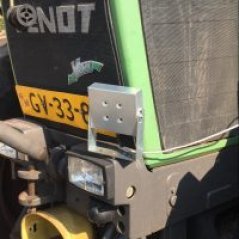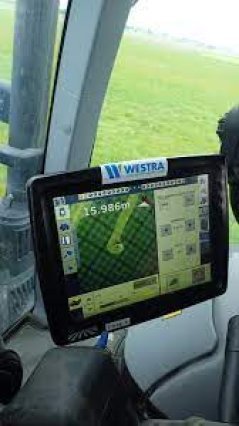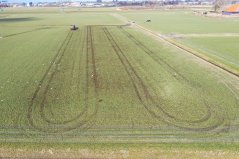
category_news
Bird-friendly approach on Dairy Campus
2020 was a bad year for meadow birds. Due to drought and predation, a record low of fledgling chicks was reached. Yet there were farmers who managed to raise their chicks with clever management. Steps are also being taken on Dairy Campus to prevent nests from being lost.
On May 12, 2021, the first cut of the land was made on almost all our plots. The postponed mowing date is maintained around the wet grasslands with the size of a football field. This usually goes along with the second cut in June.
In all cases, we mow bird-controlled, taking into account meadow bird nests and chicks. Mowing is done from the inside out to drive animals and birds to surrounding fields. We do this in close collaboration with our contractor Westra. They use two different mowing machines for this.
The Krone Big M is the most used mower on Dairy Campus. The high height of the machine gives the driver a good overview of what is happening around him in order to identify wild animals or birds in good time. The second is our newest addition, which has been available since the end of April. in use: a 12 meter wide Kongskilde GXT triple mower. Extra wide so that the tractor has to travel on less land, which is good for the soil life and therefore also for the meadow bird. Only two of these are in use in the Netherlands. This was specially purchased for the project 'With precision towards more biodiversity'.
Wildlife rescuer
To prevent mowing casualties, both mowers have a wildlife rescuer. This is a small, audible aid that can be attached to the tractor and emits a high-pitched sound in pulses that causes hares, older fawns and ground brooders in particular to startle and run away while mowing. Experiences with the wildlife rescuer in Germany show that as a result, 60 percent fewer animals become victims of mowing work.
Saving nests with GPS

In addition to alerting the animals, we also locate them. In 2017, the Association of Frisian Bird Watchers (BFVW) developed a new GPS system together with Mechanization Company Broekens to better protect meadow birds. Nests are accurately marked to 2 to 3 centimeters during mowing. At the time, Westra collaborated with several contractors on the development of this system to improve the flora and fauna.
Driving on GPS is not new, but flags appearing in the screen in the cabin when mowing are. Each flag indicates where a nest is located. It also indicates how many meters the tractor is still from the nest.
Our current working method is that aftercare workers from the local bird control point on the map where the nests are located. We then choose not to mow the entire plot, or to skip a large area around it. The GPS system will ensure that the nests will be passed on digitally to the driver. Aftercare providers pass on the exact location of the nests via a GPS measuring device. This data is loaded into the computer of the tractor and in this way the contractor can see in advance where and how many nests there are in the field to be worked. One problem is that the GPS coordinates measured via a smartphone are not yet accurate enough in practice. Further refinement is in progress. Dairy Campus expects to fully transition to GPS nest management by 2022.
Hunting Predators

In recent decades, predators in particular have caused a large reduction in eggs and birds. At the beginning of May 2020, BFVW received reports of 7,500 lapwing nests and breeding pairs of meadow birds. A fifth of this has been eaten by foxes and stone martens. The number of small mustelids, such as stoats, polecats and weasels, is striking. The chicks are eaten in abundance by the many herons and harriers. On Dairy Campus we mainly deal with the stone marten that is regularly spotted by our hunter.
Favorable soil life
At the end of 2020, a trial was started at the Dairy Campus with a raised groundwater level in combination with working on fixed driving paths, as part of the aforementioned project 'With precision towards more biodiversity'. This could potentially lead to more herbaceous grassland and more meadow birds with constant roughage production.
Wetting by raising the groundwater level is beneficial for herbaceous vegetation and also for meadow birds. The birds can then more easily pick up insects from the soil. The use of fixed driving paths prevents soil compaction outside the fixed driving paths and therefore wet, low-oxygen conditions. These are bad for soil life and ideal for fungi and crop diseases. By preventing soil compaction, we also expect to generate a grass yield between 10 and 20%. With this we want to free up considerable space for biodiversity in the next three years. We will also leave a biodiverse edge of 10 meters wide on these plots. This serves, among other things, as a shelter for game and meadow birds and also increases biodiversity.
Attention to biodiversity

Farmers and land users work together in agricultural collectives on appropriate management in which sufficient food and safe breeding places can be found for the meadow birds. For example, since 2021 we have been participating in "Natuerkoöperaasje Baarderadiel" a local nature cooperative, with a number of plots outside Leeuwarden. They are committed to guiding and stimulating many forms of meadow bird management.
At Dairy Campus we also work a lot in this area with the bird watchers and hunters who have this region under their care. In addition, measures are being taken on the nearby plots, such as mowing later and sowing herbaceous grassland or field margins because of the growing attention to increasing biodiversity.
Various trials are currently underway on the cultivation of herb-rich grasses. In the autumn of 2020, preparations were made for the 'With precision towards more biodiversity' project. The ambition is to focus on biodiversity on 25% of our total business area. There is also room for biodiversity on the remaining 75%, but not as a primary goal.
Innovating with meadow birds
Saving meadow birds thanks to GPS-controlled mowing machines, as described earlier in this article, was tested in 2008 via a prototype and has now been made ready for practice. But there are several interesting technological developments: the use of drones, infrared cameras on the tractor, image recognition and Big Data are a few appealing examples of this. Dairy Campus will organize a knowledge event on this theme in 2022.
